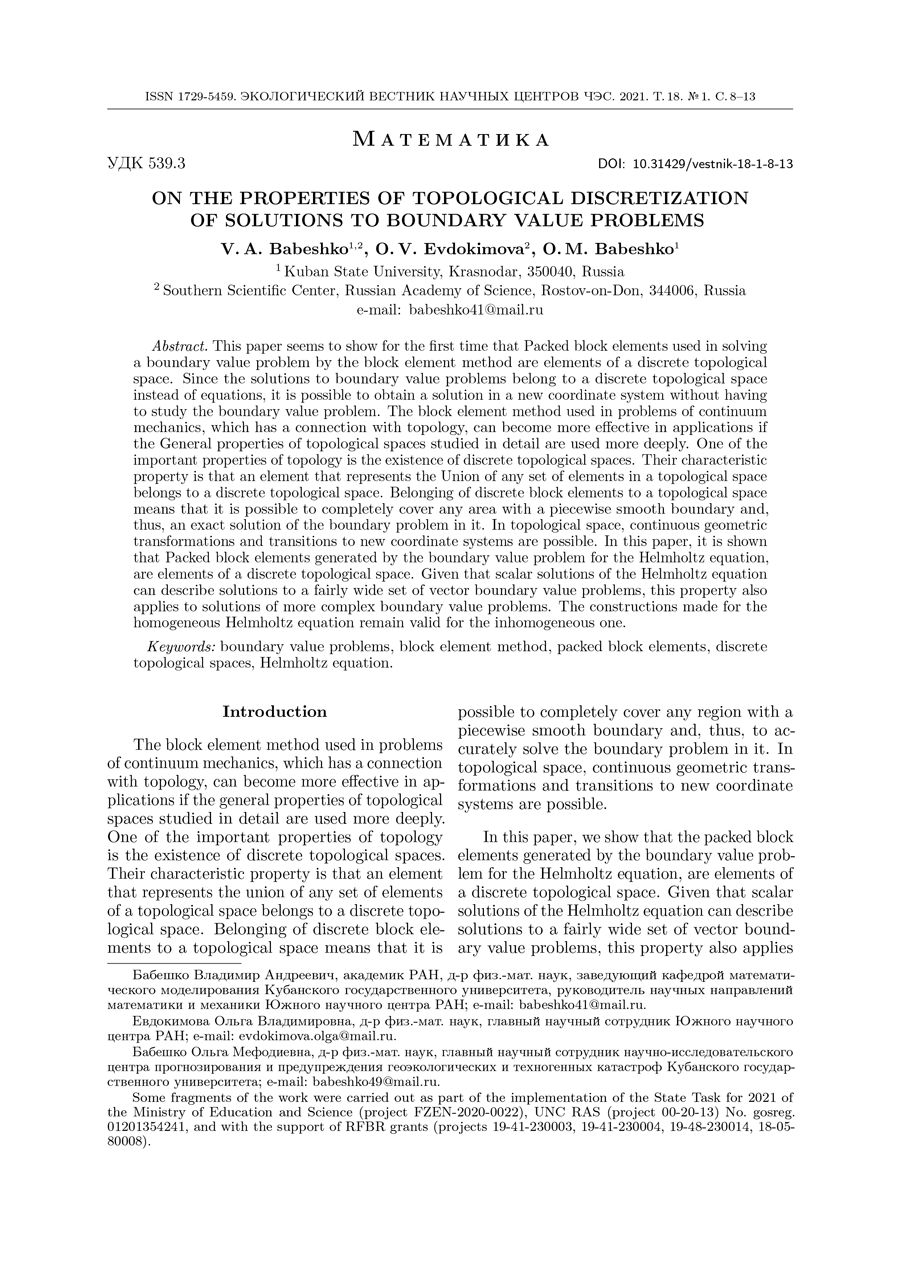On the properties of topological discretization of solutions to boundary value problems
UDC
539.3DOI:
https://doi.org/10.31429/vestnik-18-1-8-13Abstract
This paper seems to show for the first time that Packed block elements used in solving a boundary value problem by the block element method are elements of a discrete topological space. Since the solutions to boundary value problems belong to a discrete topological space instead of equations, it is possible to obtain a solution in a new coordinate system without having to study the boundary value problem. The block element method used in problems of continuum mechanics, which has a connection with topology, can become more effective in applications if the General properties of topological spaces studied in detail are used more deeply. One of the important properties of topology is the existence of discrete topological spaces. Their characteristic property is that an element that represents the Union of any set of elements in a topological space belongs to a discrete topological space. Belonging of discrete block elements to a topological space means that it is possible to completely cover any area with a piecewise smooth boundary and, thus, an exact solution of the boundary problem in it. In topological space, continuous geometric transformations and transitions to new coordinate systems are possible. In this paper, it is shown that Packed block elements generated by the boundary value problem for the Helmholtz equation, are elements of a discrete topological space. Given that scalar solutions of the Helmholtz equation can describe solutions to a fairly wide set of vector boundary value problems, this property also applies to solutions of more complex boundary value problems. The constructions made for the homogeneous Helmholtz equation remain valid for the inhomogeneous one.
Keywords:
boundary value problems, block element method, packed block elements, discrete topological spaces, Helmholtz equationAcknowledgement
References
- Babeshko V.A., Evdokimova O.V., Babeshko O.M. Topologicheskiy metod resheniya granichnykh zadach i blochnye elementy [Topological method for solving boundary problems and block elements]. Doklady Akademii nauk [Rep. of the Academy of Sciences], 2013, vol. 449, no. 4, pp. 657–60. (In Russian)
- Babeshko V.A., Evdokimova O.V., Babeshko O.M. O topologicheskikh strukturakh granichnykh zadach v blochnykh elementakh [On topological structures of boundary value problems in block elements]. Doklady Akademii nauk [Rep. of the Academy of Sciences], 2016, vol. 470, no. 6, pp. 650–54. (In Russian)
- Zorich V.A. Matematicheskiy analiz. Ch. 2 [Mathematical analysis. Pt. 2]. MTsNMO, Moscow, 2002. (In Russian)
- Kelli D. Obshchaya topologiya [General topology]. Nauka, Moscow, 1968. (In Russian)
- Mishchenko A.S., Fomenko A.T. Kratkiy kurs differentsial'noy geometrii i topologii [A short course in differential geometry and topology]. Fizmatlit, Moscow, 2004. (In Russian)
- Golovanov N.N., Il'yutko D.P., Nosovskiy G.V., Fomenko A.T. Komp'yuternaya geometriya [Computer geometry]. Akademiya, Moscow, 2006. (In Russian)
- Babeshko V.A., Evdokimova O.V., Babeshko O.M. Treshchiny novogo tipa i modeli nekotorykh nano materialov [Cracks of a new type and models of some nano materials]. Izvestiya RAN. Mekhanika tverdogo tela [Izvestiya RAN. Rigid body mechanics], 2020, no. 5. (In Russian)
- Novatskiy V. Teoriya uprugosti [Elasticity theory]. Mir, Moscow, 1975. (In Russian)
- Novatskiy V. Dinamicheskie zadachi termouprugosti [Dynamic problems of thermoelasticity]. Mir, Moscow, 1970. (In Russian)
- Novatskiy V. Elektromagnitnye effekty v tverdykh telakh [Electromagnetic effects in solids]. Mir, Moscow, 1986. (In Russian)
- Ulitko A.F. Metod sobstvennykh vektornykh funktsiy v prostranstvennykh zadachakh teorii uprugosti [The method of eigenvector functions in spatial problems of elasticity theory]. Naukova Dumka, Kiev, 1979. (In Russian)
- Grinchenko V.T., Ulitko A.F. Ravnovesie uprugikh tel kanonicheskoy formy [Equilibrium of elastic bodies of canonical form]. Naukova Dumka, Kiev, 1985. (In Russian)
- Golovchan V.T., Kubenko V.D., Shul'ga N.A., Guz A.N., Grinchenko V.T. Dinamika uprugikh tel [Dynamics of elastic bodies]. Naukova Dumka, Kiev, 1986. (In Russian)
- Gel'fand I.M., Minlos Z.A., Shapiro Z.Ya. Predstavleniya gruppy vrashcheniy i gruppy Lorentsa, ikh primeneniya [Representations of the rotation group and the Lorentz group, their applications]. Fizmatlit, Moscow, 1958. (In Russian)
- Kochin N.E. Vektornoe ischislenie i nachala tenzornogo ischisleniya [Vector calculus and beginnings of tensor calculus]. Nauka, Moscow, 1965. (In Russian)
Downloads
Submitted
Published
How to Cite
Copyright (c) 2021 Babeshko V.A., Evdokimova O.V., Babeshko O.M.

This work is licensed under a Creative Commons Attribution 4.0 International License.




